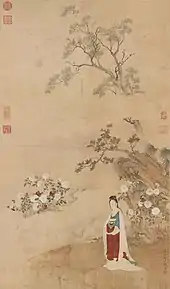Qiu Zhu
Qiu Zhu (Chinese: 仇珠; Wade–Giles: Ch'iu Chu; fl. 1565–1585), commonly known as Miss Qiu and by her art name Duling Neishi (Chinese: 杜陵内史), was a Chinese painter during the Ming dynasty, noted for paintings with figures (rather than landscapes), including several depictions of the goddess Guanyin.[1]
Qiu Zhu | |||||||||||
|---|---|---|---|---|---|---|---|---|---|---|---|
 White Robed Guanyin, collection of the National Palace Museum, Taipei | |||||||||||
| Born | first half of the 16th century | ||||||||||
| Died | after 1585 | ||||||||||
| Nationality | Chinese | ||||||||||
| Education | Qiu Ying | ||||||||||
| Known for | Painting, illustration | ||||||||||
| Movement | Wu School | ||||||||||
| Chinese name | |||||||||||
| Chinese | 仇珠 | ||||||||||
| |||||||||||
Life
Qiu Zhu was born in Taicang County, Suzhou Prefecture,[2] the daughter of Qiu Ying (1494? – 1552), one of the Four Masters of the Ming dynasty. Little is known about her life, and it is assumed that she learned to paint from her father.[2] She was possibly married to You Qiu (尤求), an artist influenced by her father and generally believed to be his son-in-law,[3] although this has been questioned by some scholars.[4] In his later life Qiu Ying lived at the estate of his patron, collector Xiang Yuanbian, and she might have also lived there. She maintained a close relationship with the Xiang family after her father's death, and at least one of her extant works bears the seal of a Xiang family member.[5]
Work

Qiu Zhu was active as an artist from around 1565 to 1585.[5] She was commissioned to produce paintings for birthday gifts, or to complement calligraphy.[2] She was also commissioned to create illustrations for Wang Chong's calligraphy of the narrative poem Nymph of the Luo River. This suggests her work was well received, as Wang was held in high esteem.[1]
A later Ming dynasty scholar considered Qiu Zhu to be a "Li Gonglin among women". Li Gonglin was a highly regarded artist in his time.[6] Qiu Zhu is noted for her use of firm brushstrokes and delicate drawing.[3]
Qiu Zhu's most famous subject is Guanyin, the bodhisattva of compassion especially appealing to women,[2] and her paintings of the goddess have been described as "mysteriously transcendent". The 24 portraits of Guanyin are presented in an album alternating them with short text passages. They are in gold ink on black paper, and were inspired by an album of woodblock prints by Ding Yunpeng (1547–1628) that had been based on a hand scroll by Li Gonglin.[7] Her acclaimed painting, White Robed Guanyin, is in the collection of the National Palace Museum in Taipei.[2] She also painted other religious figures, such as her fan painting of A Daoist Female Immortal, possibly Chang E.[8]
Her non-religious subjects are primarily women at leisure: playing xiangqi under plum blossoms, playing a guqin under wutong trees, sitting at a writing desk, or playing with a parrot. She also painted women celebrating the Double Seven Festival which is a festival honoring the Weaver Maid, the patron spirit of women's work.[2]
Qiu Zhu was considered a highly refined painter, and is seen to have influenced Wen Shu.[1]
Paintings

References
- Laing, Ellen Johnston (1988). "Wives, Daughters, and Lovers: Three Ming Dynasty Women Painters". In Weidner, Marsha (ed.). Views from Jade Terrace : Chinese women artists, 1300–1912. Indianapolis Museum of Art. pp. 34–35. ISBN 0847810038.
- Lee, Lily Xiao Hong; Wiles, Sue (2015). Biographical Dictionary of Chinese Women, Volume II: Tang Through Ming 618 – 1644. Routledge. pp. 321–2. ISBN 978-1-317-51562-3.
- "Four Great Masters of the Ming Dynasty: Qiu Ling". National Palace Museum Taiwan. 4 October 2014. Retrieved 16 September 2019.
- Zhu Wanzhang 朱万章 (24 October 2016). "明清时期仇英作品的鉴藏与影响". Artron. Retrieved 17 September 2019.
- "Guanyin and a falling child". Johnson Museum of Art. Cornell University. Retrieved 16 September 2019.
- Weidner, Marsha (1988). "Women in the History of Chinese Painting". In Weidner, Marsha (ed.). Views from Jade Terrace : Chinese women artists, 1300–1912. Indianapolis Museum of Art. pp. 13–31. ISBN 0847810038.
- Weidner, Marsha (1988). "catalogue". In Weidner, Marsha (ed.). Views from Jade Terrace : Chinese women artists, 1300–1912. Indianapolis Museum of Art. pp. 70–72. ISBN 0847810038.
- "A Daoist Female Immortal, possibly Chang E". Portland Museum. Retrieved 17 September 2019.
- "Qiu Zhu (16th century)". Christies. Retrieved 16 September 2019.
External links
 Media related to Qiu Zhu at Wikimedia Commons
Media related to Qiu Zhu at Wikimedia Commons